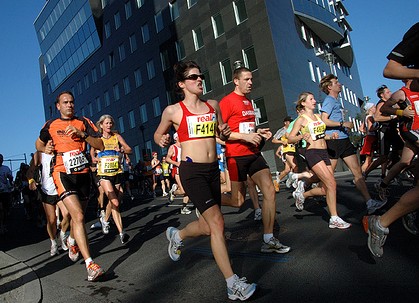Crossing the finish line of a marathon is a moment of unparalleled triumph, where 42.2 kilometres of effort, early mornings, and relentless training culminate in a surge of pride. Humans are ultra competative we even love competion and the thrill of winning in our own homes, taking part in activies like playing video games and for the more adventerous a wanted win no deposit bonus could be the way to go. The journey to that moment of victory for running a marathon, however, demands careful preparation, typically spanning 12 to 20 weeks, tailored to your experience and fitness level. While no single training plan is universally perfect, proven principles underpin most successful programmes. This guide explores how to embark on your marathon journey, select your first race, master training essentials, optimise hydration and fuelling, and navigate race day and recovery, all in British English.
Preparing for the Marathon Journey
Health and Fitness Assessment
Before diving into marathon training, consult a healthcare professional to ensure it’s safe for you. A doctor can assess your overall health, identify risks, and confirm your readiness, especially if you’re over 40, have physical limitations, are new to running, or returning after a long hiatus. This step is crucial to avoid injuries and ensure a sustainable training process.
Building a Running Base
A solid foundation of consistent running is essential before tackling a marathon. Aim for at least a year of regular running, reaching 32–48 kilometres per week without injury. Rapidly increasing mileage is a common cause of setbacks, so gradual progression is key. Use this base-building period to race shorter distances, such as 5K or 10K events, progressing to a half marathon. These races build endurance and confidence while preparing you for the full 42.2 kilometres.
Incorporating Cross-Training
Cross-training activities like cycling, swimming, or using an elliptical trainer offer low-impact ways to boost aerobic fitness without overloading your joints. Replace easy runs—shorter, conversational-paced sessions—with cross-training, matching the duration rather than distance. For example, a 30-minute easy run could become a 30-minute cycle in heart rate zone 2. Cross-training can also increase weekly training volume safely; a 30-minute run might extend to an hour on an elliptical, enhancing endurance with minimal injury risk.
Staying Motivated
Consistency thrives on accountability. Partner with a friend for regular runs, join a local running club, or hire a coach for personalised guidance. Platforms like Strava foster friendly competition and community support. Sharing your journey keeps training engaging and fun, helping you stay committed through the gruelling weeks ahead.
Selecting Your First Marathon
Exploring Race Options
Marathons vary widely, from intimate rural races to bustling urban events with thousands of runners. To gauge what suits you, try shorter races, volunteer at local events, or spectate to absorb the atmosphere. These experiences help identify whether you prefer a low-key setting or a vibrant, spectator-filled course.
Local vs. Destination Races
A local marathon offers familiarity, letting you train on the course, sleep at home, and enjoy support from friends and family. Conversely, a destination race—requiring travel—adds adventure and motivation, turning the event into a memorable trip. Consider logistics, costs, and your preference for comfort versus excitement when deciding.
Researching the Race
Thorough research is vital. Investigate the race’s history, inclusivity, and reputation. Review the course profile for elevation changes, expected weather, and logistical details like start times and transport. Understanding these factors ensures you’re prepared for race day challenges, whether you aim to finish or target a specific time.
Core Elements of Marathon Training
Training Duration and Structure
Most marathon training plans span 16 weeks, though some extend to 20 for beginners or those aiming for specific times. Weekly schedules typically include three to five runs, with mileage gradually increasing before tapering—a reduction in volume before race day to ensure freshness. Non-running days are ideal for cross-training, yoga, or Pilates, with at least one full rest day to aid recovery.
Types of Runs
Training plans feature varied runs to build endurance, speed, and resilience. Easy runs, done at a conversational pace, develop aerobic fitness. Long runs, typically once a week, mimic race conditions, gradually extending to 29–32 kilometres. Speed sessions, like intervals or tempo runs, improve pace and efficiency. Each run serves a purpose, and pacing varies based on factors like sleep, diet, and stress, so avoid fixating on consistent speeds.
Setting Realistic Goals
For first-time marathoners, focus on completing the 42.2 kilometres rather than chasing a specific time. Experienced runners can use past race times or a pace calculator to set achievable targets, such as sub-5-hour or sub-4-hour finishes. Training plans tailored to these goals provide structure, balancing effort and recovery to prevent burnout.
Hydration and Fuelling Strategies
Practising Nutrition
Proper hydration and fuelling are critical for marathon success. Practise your race-day nutrition during long runs, testing energy gels, chews, or sports drinks to find what suits your stomach. Aim to consume 30–60 grams of carbohydrates per hour during the race, starting early to maintain energy. Hydrate regularly, sipping water or electrolyte drinks at aid stations, but avoid overdrinking, which can cause discomfort.
Race Day Planning
Plan your fuelling schedule in advance, noting aid station locations on the course map. Carry gels or snacks if you prefer specific products, and test your hydration belt or handheld bottle during training. Consistency between training and race day minimises surprises, ensuring your body is primed for the distance.
Race Day Essentials
Pre-Race Preparation
Arrive early to account for parking, bag drops, and toilet queues. Stick to a familiar breakfast, tested during training, and wear broken-in shoes and clothing. Check the weather and layer appropriately, discarding extra layers at the start. Review the course map and pacing strategy, but stay flexible—crowds or adrenaline may affect your early pace.
During the Race
Start conservatively to avoid burning out. Use aid stations efficiently, grabbing drinks without stopping if possible. Break the race into segments—focus on reaching 10K, then halfway, then the final 10K—to stay mentally engaged. If fatigue sets in, slow your pace or walk briefly, but keep moving. Draw energy from spectators and fellow runners to push through tough moments.
Post-Race Recovery
After crossing the finish line, keep walking to prevent muscle stiffness. Refuel with a mix of carbohydrates and protein within 30 minutes, such as a banana and yoghurt. Hydrate well, and consider a gentle stretch or ice bath to ease soreness. Take at least a week off running, using light activities like walking or yoga to aid recovery. Reflect on your achievement, but resist signing up for another race immediately—give your body time to heal.
Long-Term Benefits and Next Steps
Completing a marathon builds physical and mental resilience, boosting confidence and discipline. Use this momentum to set new goals, whether improving your time, tackling an ultramarathon, or exploring trail running. Maintain a base of 24–32 kilometres per week to stay marathon-ready, and consider joining a running community to share experiences and plan future races. With dedication and smart planning, your marathon journey can be the start of a lifelong passion.

